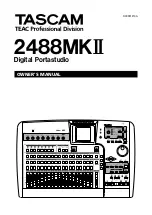
TASCAM 2488MKII
1 − Introductions
This User's Manual is comprised of the following chapters.
In addition to an overview of the unit and information
about CD-R/CD-RW discs and other features, this chapter
explains the structure of this User's Guide and describes
the conventions used in it. This chapter also includes
important notices about copyright and liability.
2 – Setting up and basic knowledge (page 12)
Read this chapter before operation. This explains setup,
startup, shutdown, and other basic knowledge necessary to
use the unit.
3 – Names and functions of the 2488MKII (page 17)
This chapter explains the functions of the control keys and
knobs on the top panel of this unit, the connection jacks
and other parts.
The example in this chapter explains the basic functions
needed to use the 2488MKII to make recordings.
This chapter explains the 2488MKII’s extensive mixer
functions, including input assignment, EQ and effect
sends, as well as scene memory and other functions that
are useful in regular operation.
This 2488MKII includes three types of digital effects –
mic insert effects, guitar insert effects, and a single effect
useful at mixdown. This chapter explains these effects and
how to use them in detail.
The 2488MKII’s 24-track recorder has numerous advanced
functions, including mark points, auto punch recording
(including rehearsal functions), undo/redo and virtual
tracks. This chapter explains these recorder functions in
detail and how to use them.
8 – Mastering and CD recorder (page 69)
This chapter explains the procedures for creating a stereo
master track after recording and the procedures for making
audio CDs using the internal CD recorder. It also covers
other CD recorder functions.
This chapter explains how to reformat the entire internal
hard disk or specific partitions.
10 – File import/export (page 77)
This chapter explains file import and export. Audio data
files can be imported and exported between this unit's
internal hard disk and a connected personal computer, or
between the internal hard disk and a CD-R/CD-RW disc.
SMF files can also be imported.
11 – Backup and restoration (page 83)
This chapter explains backup and restoration of song data.
This unit can back up and save song data to CD-R/CD-RW
discs and connected computers. The data in these files can
later be restored to this unit for further use.
This chapter explains the unit's tempo management
functions (tempo map, metronome) and MIDI functions
(synchronization, SMF playback, mixer/effect control).
13 – General preferences (page 92)
This chapter explains the preference settings and how to
adjust them according to your project conditions.
14 – Specifications, etc. (page 94)
This section includes electrical and mechanical specifica-
tions and block and level diagrams.
This part provides additional information, including details
of MIDI messages used to control this unit and a list of
warning messages.
About this User's Manual
Manual conventions
In this manual, we use the following conventions:
Controls and indicators on the 2488MKII are written
like this:
HOME
.
Inputs and controls of other equipment are written like
this:
AUX IN
.
Messages shown on the display are written like this:
Are you sure?
.
If a preset indicator (i.e. one which cannot change) is
shown, it is written like this:
TEMPO
.
•
•
•
•
We use the term “soft switch” or “button” to describe
an on/off control on the display. Also note the differ-
ence between “disc” and “disk.” When we refer to a
disc, we are refer to a CD-R, CD-RW or pre-recorded
audio CD. A disk, on the other hand, refers to the
2488MKII’s internal hard disk drive, or that of a
connected computer.
We use the term “key” to describe a push-button control
on the 2488MKII’s surface.
•
•










































